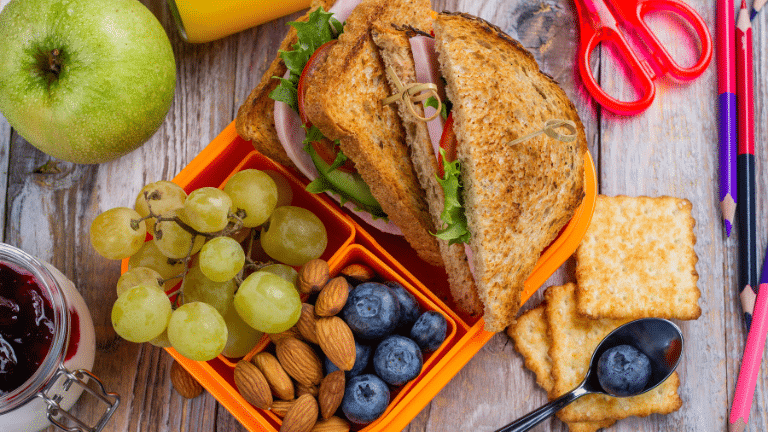
The snack aisle at the supermarket is a minefield when it comes to healthy vs ‘fake healthy’ convenience foods. Dr Rachel Sutherland from HMRI’s Population Health Research Program says there are plenty of good choices for a healthy, nutritious packed lunch – you just need to know what they are.

Dr Rachel Sutherland from HMRI’s Population Health Research Program says there are plenty of good choices for a healthy, nutritious packed lunch – you just need to know what they are.
In this Q&A, she shares her advice for making better lunchbox choices.
One very misleading item is fruit drinks.
Fruit drinks are normally packaged in conveniently sized poppers which are easy to add into your child’s lunchbox. These often contain little to no real fruit juice and high amounts of added sugar.
Fruit drinks also have a high glycaemic index, meaning that your child may get a big spurt of energy but then crash and feel fatigued not long after.
This can then affect their behaviour and performance at school.
Other ‘sometimes’ snacks that are commonly creeping into lunchboxes everyday include chips or crisps, and sweet biscuits and cakes.
These foods fall outside of the Australian Dietary Guidelines and should be consumed occasionally rather than every day at school.
When packing a lunchbox, aim to choose a recess and a main lunch item from foods that align to the Australian Guide to Healthy Eating.

The Australian guide to healthy eating is a food selection guide which visually represents the proportion of the five food groups recommended for consumption each day. Source: National Health and Medical Research Council
This simple eating guide contains five core food groups:
Don’t forget to also include something for vegetable and fruit break to keep the concentration and energy levels up. Plus, plenty of water to stay hydrated.
Aim to include a variety of foods from each food group as they each provide key nutrients.
“One of our favourite combos is a multigrain wrap with lettuce, tomato, cheese and chicken paired with a small tub of yoghurt and berries.”
Extra vegetables such as cherry tomatoes or a carrot for vegetable and fruit break completes the healthy lunchbox.
Food safety can be an issue, especially in our warm summer months.
Parents report food safety concerns as one of their biggest barriers to packing healthy lunchbox items that kids love.
It is important to ensure all perishable foods are kept cool throughout the school day. The risk of food poisoning increases the longer food is within the danger zone (>5°C and <60°C).
How to keep your child’s food cold:
Although any food can spoil, some food options that are low risk include:
Variety is great and can make lunchtimes more interesting, but it really comes down to personal preference.
Whether the lunchbox constantly changes or remains the same every day, the most important thing to aim for is choosing foods that align to the Australian Guide to Healthy Eating.
These foods help children concentrate and learn so they can thrive at school. They also enhance their health and overall wellbeing.
When trying to incorporate more foods from the five core food groups into a lunchbox you can also try to make it fun and appealing. Some ideas to include may be:
Our SWAP IT research has shown that the majority of food consumed by children comes from lunchboxes, with more than 86% of children having a packed lunchbox every day.
However, tuckshop or canteen orders can be fun for children and can often encourage children to try new foods.
The good news is that the NSW government has strategies in place to help promote the sale of healthier food and drinks via the school canteen.
Aim to choose the everyday options from the school canteen menu to build a healthy lunchbox. By including more everyday foods from the five core food groups, you can ensure that the majority of your child’s intake is coming from nutritious foods.
Our SWAP IT program has a swap suggestion for any food you can think of. Some of common swap suggestions include:
It can be hard to find the time to make healthy school snacks or lunches but there are easy, simple lunchbox ideas that don’t take too much time or fuss.
Some simple hacks to reduce time and effort are:
With almost a half of a child’s daily food intake occurring at school, the foods children consume at school really does matter.
Not only does healthy lunchbox food help children to concentrate, learn and thrive at school academically, it also supports their health and wellbeing.
Our research shows that 40% of the foods packed inside lunchboxes comes from discretionary foods – those that fall outside of the Australian guide to Healthy Eating.
Swapping out discretionary foods and replacing them with everyday foods aligned to the Australian Guide to Healthy Eating, ensure children are better prepared to learn and play.
Find out more about healthy lunchbox swaps here: www.swapit.net.au
HMRI would like to acknowledge the Traditional Custodians of the land on which we work and live, the Awabakal and Worimi peoples, and pay our respects to Elders past and present. We recognise and respect their cultural heritage and beliefs and their continued connection to their land.
Hunter Medical Research Institute
We’re taking healthy further.
Locked Bag 1000
New Lambton
NSW, Australia, 2305


This site is protected by reCAPTCHA and the Google Privacy Policy and Terms of Service apply.
Copyright © 2024 Hunter Medical Research Institute | ABN: 27 081 436 919
Site by Marlin Communications
